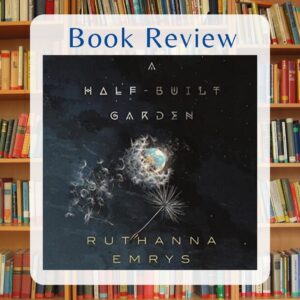
A Half-Built Garden by Ruthanna Emrys
Book Review by Kristine Madera
 I picked up this book because speculative writer Ruthanna Emrys organized some of her future Earth around watershed communities, an idea I find interesting in terms of living in a more custodial, symbiotic relationship with Earth. But wow, Emrys dove deep into the theme of symbiosis both socially and technologically.
I picked up this book because speculative writer Ruthanna Emrys organized some of her future Earth around watershed communities, an idea I find interesting in terms of living in a more custodial, symbiotic relationship with Earth. But wow, Emrys dove deep into the theme of symbiosis both socially and technologically.
A Half-Built Garden opens with Judy Wallach-Stevens noticing pollutants in the Chesapeake watershed and taking her infant daughter to check on it, only to find that an insect-like alien species (Ringers) has landed to save humanity by removing them from Earth to come live in symbiosis with them in their stellar, space-based habitats. For the Ringers, experience has taught them that high-technology societies destroy planets and themselves if they don’t move into space habitats in time. Thus, they are thrilled, in a savior-complex way, to find a species at our level of technology that hasn’t yet killed themselves off by destroying their planetary habitat, as they have arrived too late to help three other species at our stage of development. Judy and the watershed communities, who use a complex dandelion decision tree to reach consensus, are learning to work with Earth and believe they can adapt human life and Earth’s systems to live in symbiosis over the long term. But not everyone on Earth lives in watershed communities, and other interests, including next-generation corporations, are interested in life in space for various reasons. Thus is the plot crux of the book.
I’d have liked more about the arguments for and against the idea that high-technology societies need to move at least most of their population into space to survive. This idea is mirrored in current life with people like Bezos and Musk and many governments looking at colonizing other planets and habitat spaceships as a future where trillions of Earth-origin humans inhabit the universe at the same time. But that’s not what the book is about.
A Half-Built Garden is an intricate look at finding symbiosis not just with technology and natural systems, but between species, cultures, and people, and how finding symbiosis on one level doesn’t always translate to finding it on another level—though it can serve as a foundation.
Emrys is wildly imaginative in how both humans and the Ringers have organized socially around things like gender, family relationships, power, and decision-making. The Ringers make family structure central to political and power structures. For example, for them, bringing your kids to an alien invasion and diplomatic negotiations is critical to finding common values and demonstrating a willingness to cooperate. Emrys also explores varying physical capacities and communication abilities by contrasting human vocalism and bipedalism with the Ringers multi-eyed, multi-legged, tactile communication. We even get a glimpse of life in the Ringer habitats, where two species already live in symbiosis.
It’s a deeply thoughtful book that looks at intergalactic cultural exchange through the lens of learning to communicate and cooperate rather than the invasion and war scenario that dominates movies and many books. As Emrys says in an interview, “I have trouble seeing how a propensity for murderous invasion is compatible with the level of internal cooperation needed for interstellar travel.” An idea I think we need to spend more time pondering in our shoot-first-regret-or-celebrate-later approach to the idea of alien contact. Find the full interview with Emrys at https://www.bookpage.com/interviews/ruthanna-emrys-interview/
You won’t get the adrenaline high of intergalactic war in this book (thank God!) But if you are looking to expand your idea of what is possible in space, between species, and even between human groups with different interests, add this book to your reading list.
Imagineering Protopia
As a species, we are dabbling with the possibility of living in space and on other planets as we stretch the limits of Earth. A common argument for this is one the Ringers made—that beyond a certain level, technologically advanced species chew through planets and thus need to live non-terrestrially, perhaps with enough proximity to a nice planet they can visit. One issue with terrestrial life and technology is the amount of power/electricity it takes to run the kind of advanced technological systems that sustain an advanced society. We’re on the cusp of this ourselves with the massive amount of power that things like crypto and AI need pushing the limits of our grid systems and pushing up the cost of energy so high that is creates housing and food insecurity for many households.
Some form of free or highly efficient, non-polluting, and (to me) non-grid-based energy is needed not only to progress technologically on Earth and as a species but also to develop the ability to live on other planets or in space. Chevron can’t truck fuel to space and it’s naive, backward thinking to assume that our current menu of fossil fuels, green fuels, and limited grid systems will be adequate for the technological advancement that we imagine a hundred years from now. The Ringers solved their energy problem by using planets and gasses to build a mega-structure Dyson Sphere. They were coming to “rescue” humans from extinguishing themselves and inviting them to join their galactic habitats, in part, it was suggested, so they could use our solar system as fuel for their Dyson sphere. Yikes.
Another issue that Emrys brings up is who would decide humanity’s future in a situation like the Ringer’s “invasion” and invitation. Currently, this would be consigned to governments, military, and corporate interests that already speak for only a few and not the many. Their power would magnify exponentially if these interests were able to act on behalf of all humanity in space. We have no effective method for collective decision-making that represents humans individually or as a species. Human interest has been parsed into nations, militaries, corporations, and other factions with limited, self-interested, views. The messy, disjointed decision-making process Emrys discusses would be a stepping stone at best—and yet is an optimistic scenario given the state of today.
The idea of moving to space and being in contact with other species requires cooperation, communication, and many other skills we need to cultivate both personally and as a species. I’m sure some people and organizations are working on this. To do this with another species, we need to be able to do that within our own. For as crazy, pie-in-the-sky as this might sound in our fractured, fractious world, there are many people and organizations all over the planet who are working hard to help humans band together in collective humanity and solve problems through collaboration and common ground rather than guns and violent rhetoric.
So there’s hope! Yea!

About Kristine
Kristine Madera is a #1 bestselling Amazon author, novelist, hypnotherapist, and pro-topian with a passion for helping people better themselves and the world. Informed by global travel, teaching abroad, and a stint as a Peace Corps Volunteer, Kristine believes that everyone plays a part in imagining and creating our collective future.
Volunteering at Mother Teresa’s Home for the Dying in Calcutta inspired her novel, God in Drag. She birthed her upcoming novel, The Snakeman’s Wife, as a Peace Corps Volunteer in Papua New Guinea.
Read the first chapter of God in Drag HERE
